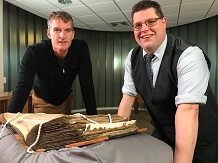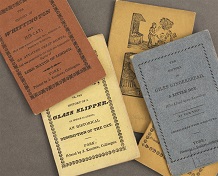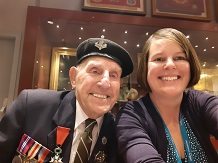Borthwick Newsletter - December 2022
Posted on 30 November 2022
December in the Archives - delve into our catalogues with this month’s featured description
A commonplace book containing the customs of the manor of Wistow 1711; rents due to the archbishop 1710-1711; list of landowners with a valuation of their lands 1712; account of receipts (mostly for sale of animals) at Beckingham 1823-1824; valuation of fixtures at Beckingham Park 1823; note on roads and paths in Cawood and Wistow early 18th century; mathematical notes and tables early 18th century; miscellaneous notes on weather, natural phenomena, famous men, foreign lands etc., early 18th century; remedies for various human illnesses early 18th century; acreage in the woods early 18th century; remedies for animals early 18th century; notes on the family and on their farming activities, early 18th century.
[Miscellaneous Documents, The Book of Remarks of William Storr, MD/112]
What’s new?

On 18th November, we launched our new Instagram account, @uoyresearchcoll! Please follow us over there as one of the ways to keep up to date with our new content. We will still be posting to our Twitter account too, but you can also find updates on all our news and services (plus lovely pictures of archives and rare books!) through our Facebook page and our news pages too. We’re currently sharing plenty of pictures and insights as part of this year’s Explore Your Archive week so please do go and have a look!
You might remember that over the summer, due to large-scale upgrades to our strongroom shelving, we barcoded and despatched 3,500 boxes to Deepstore. Although we have been able to order items back on request for our researchers throughout the works, we’re really pleased that we have now started to bring material back to the Borthwick! The first pallets have been returned to their homes on the new shelving now, with all the parish records now back onsite here. We’ll be continuing to bring items back each week over the coming month.
On 5th November our Access and Digital Engagement Archivist, Laura, was co-opted to the Trustees of the British Association for Local History (BALH). Subject to being formally elected at the AGM in May next year, Laura will serve as a Trustee for the next three years. She is really looking forward to supporting the work of BALH, particularly in terms of their outreach work.
We were delighted to host historian and TV presenter Dan Snow in early November. Dan was filming with Gary, our Keeper of Archives and Research Collections, for a TV series to be broadcast next year. We'll keep the exact details under wraps for now, but watch this space and we'll let you know when it airs!
New Accessions
Over the past month we have taken in a number of additions to our existing collections including the University of York Archive, our Rowntree Company collections, the archive of Trevor Wishart and also materials from a number of different parishes across York and the surrounding area. We have also taken in an additional deposit of material from the closed branches of the Women’s Institute in North and East Yorkshire.
New Catalogues
During November we have continued with our work retroconverting our parish record finding aids into Borthcat with new catalogues added for the parishes of Poppleton, Micklefield, and Kilnwick Percy.
We have also published a significant number of newly indexed entries as part of The Retreat archive, as a result of the long-term work of the Retreat Letters volunteer project. The project has been running since 2016, indexing individual letters in The Retreat’s Incoming Correspondence series. This marks a huge 12,000 entries and a milestone 50% of this series being described to item level (meaning each letter in the series has its own entry on the catalogue). We’re so grateful for such a huge amount of work which opens up this fascinating collection further, and in conjunction with the digitised images available via the Wellcome Collection, allows researchers to make more in-depth connections between the people and places linked to The Retreat. One of our volunteers, Paul, has written a blog about just one of the fascinating stories the series contains, as well as his experience of working on this project.
Number of archival descriptions on Borthcat on 1st December 2022: 115, 360
Web Archiving
Have you ever clicked on a website link only to be presented with an error message informing you that the content you are looking for no longer exists? Us too. And we are not the only ones. Research has shown that the average lifespan of a website is just two years and seven months, with content published on the web often subject to even more frequent changes.
In spite of this, more and more of the information that we consume is now published exclusively online. Where once we may have received printed newsletters, leaflets, magazines, or prospectuses, we now consult a website. For the archives, this shift presents new challenges in terms of what we collect and how. In response, the Borthwick is in the process of developing a Web archiving program that will allow us to capture, preserve, and make accessible snapshots of websites relevant to our collections. These snapshots retain much of the website’s content along with the look and feel of a website, thus enabling an archives to preserve the user experience in addition to the text or images on a page.
So far, the program has focused on capturing regular snapshots of the university’s websites, but in time we hope to expand its scope to also include university research and theses published as websites, university blogs, websites created by student groups and other university-related organisations, and websites produced outside of the university and donated to the Borthwick as part of an archives. Once captured, users will be able to access and browse snapshots of the archived websites through time, much as they once would have viewed the original.
If you would like to learn more about our Web Archiving program, please get in touch with our Digital Preservation Archivist at dorothy.waugh@york.ac.uk.
News from Rare Books

This month is all about the ephemeral collection in the Rare Books Collection and at the Minster.
The Minster library has over 4000 playbills and posters, most for the York Theatre Royal. The earliest is from 1726 and the majority are 1750-1850. They range from A5 sized handbills to poster sized adverts for the night’s entertainment.
As well as the playbills there are around 700 ballads and broadsheets, and York newspapers dating from 1716 , some of which are not on the British Newspaper archive.
Rare books holds a good selection of 18th and 19th century satirical political fliers, and a collection of chapbooks especially strong in those printed by James Kendrew on Colliergate.
Add these to a number of trade catalogues advertising everything from uniforms to carriages and York has an amazing resource for studying everyday life in 18th and 19th century Yorkshire through material that has survived purely by chance.
Our ephemeral collection has been used in seminars this term and is available in the Borthwick searchroom for further study.
Borthwick Collections Out and About

On 19th November, our Access and Digital Engagement Archivist, Laura, represented the Borthwick at York Army Museum’s Military Memorabilia Day. She spoke to over thirty researchers who had questions about their military research - and was delighted to be reunited with York Normandy Veteran Ken Cooke at the event too! The Borthwick has a large number of collections that might help your military research, covering the Boer War, First and Second World Wars, Falklands War and Gulf War as well as earlier material from other conflicts. Please just get in touch with your queries on borthwick-institute@york.ac.uk and we’ll be happy to help.
Archive of the Month: York Dispensary Archive
What is it? The archive of the York Dispensary, which started out as a subscription-based medical charity and now operates as the York Dispensary Charitable Trust.
Where can I find it? The catalogue to the York Dispensary Archive is available through Borthcat
Why is it Archive of the Month?
York Dispensary opened in 1788 as a subscription-based charity funded by wealthy patrons. As you might expect, the subscriptions list published in the early annual reports include many well-known York names - the Tukes, the Terrys, the Camidges and the Fairfaxes as well as Lady Conyngham. The Dispensary was founded solely to serve the poor of the City of York by treating the chronic health problems and illnesses such as smallpox, measles and whooping cough which fell outside the responsibilities of the existing County Hospital, treating the poor both in their own homes and at the dispensary itself. In addition to this, the Dispensary also ran a domiciliary midwifery service. This service, which ran until 1801 and then began again in 1895, was the precursor to Acomb Maternity Hospital, an institution run jointly between the Dispensary and York Corporation.
In its first fifty years York Dispensary treated 83,000 patients. Between 7,000 and 9,000 patients were seen per year in the 1890s, around 10% of York’s population attended the Dispensary annually in the early 1900s, and in 1938 the doctors paid 5,842 home visits, had consultations with 2,871 visiting patients, and dispersed 35,957 prescriptions. The Dispensary’s doctors and dentists carried out a large number of routine operations: to treat abscesses and septic wounds; remove teeth, tonsils, cysts, and growths; as well as amputate fingers. Some procedures were even carried out in the patients’ homes! The anaesthetics used included gas, ether, chloroform, and cocaine.
The Dispensary moved buildings several times during its life: starting in two rented rooms in the Merchant Adventurers Hall, before moving to St. Andrewgate in 1806 and then New Street in 1827. It was finally located in a purpose-built site in Duncombe Place in 1899. Although the services of the Dispensary in their original form were made redundant by the advent of the NHS, it still operates as a charitable foundation within the city.
We’ll be back with more news next month!

